
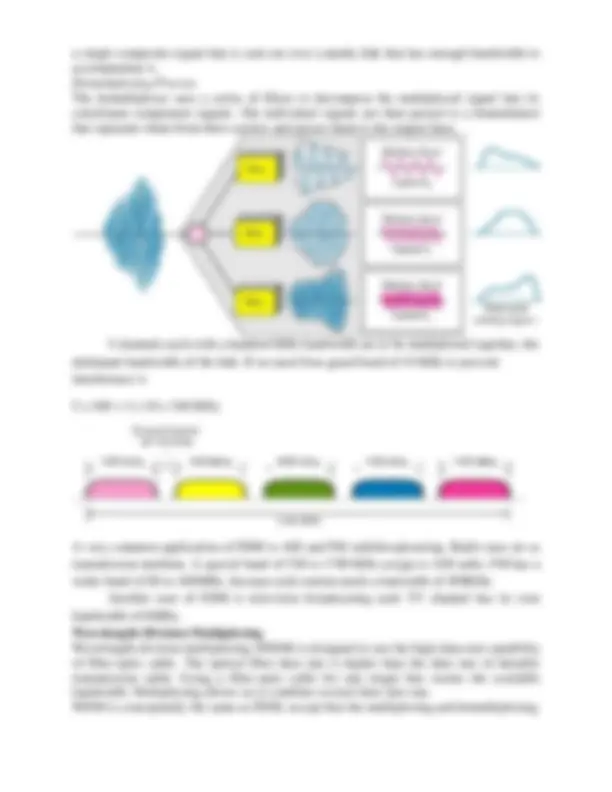
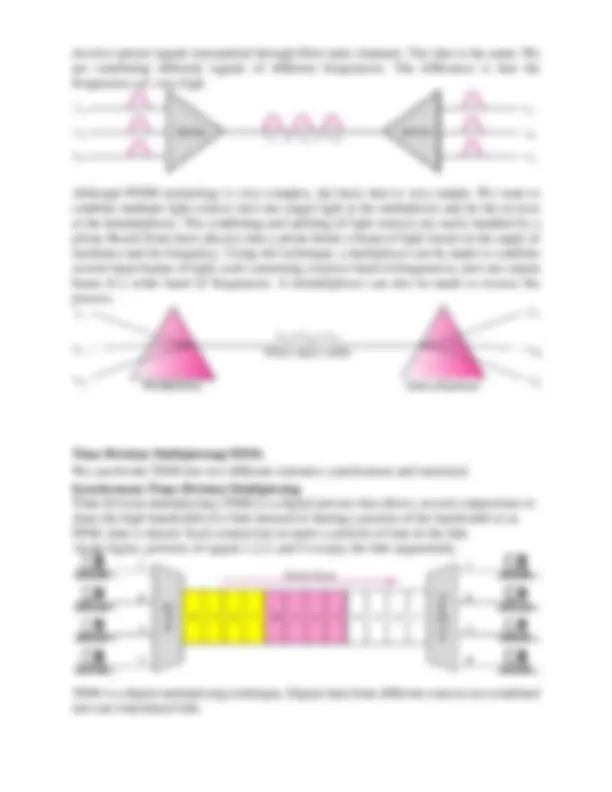
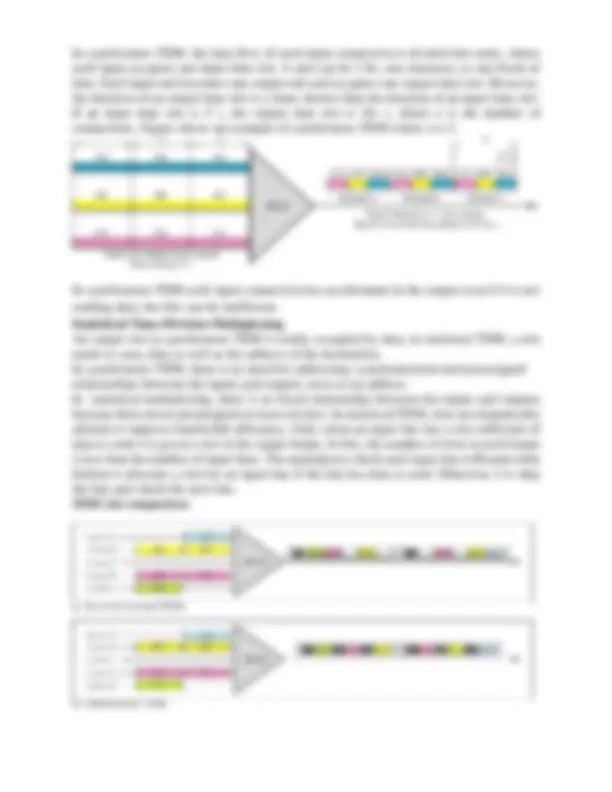
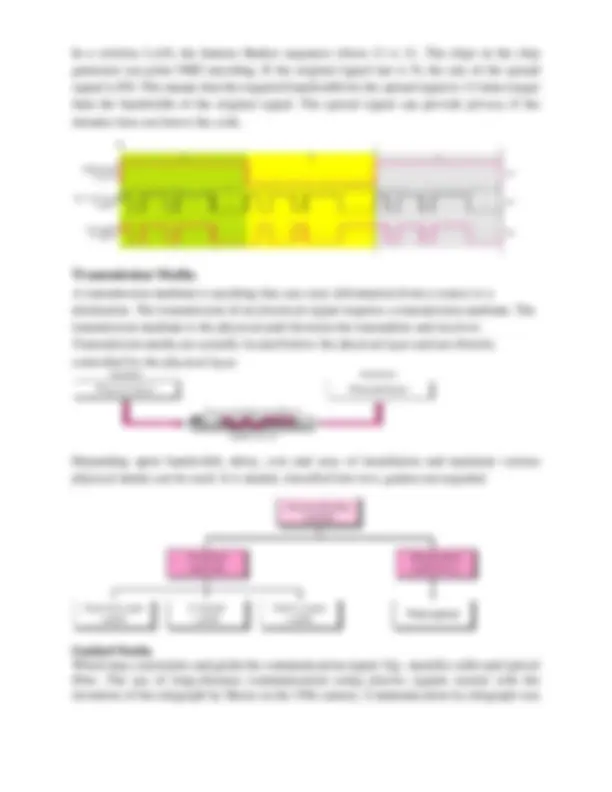
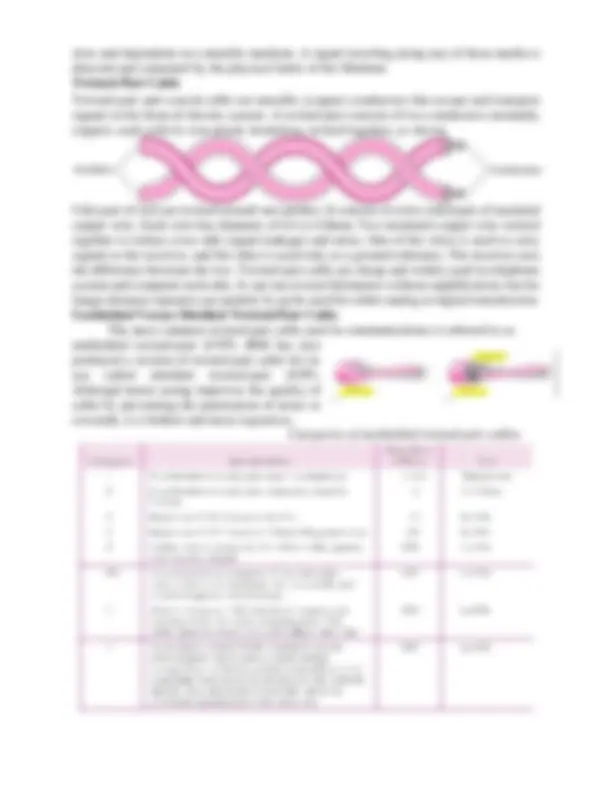
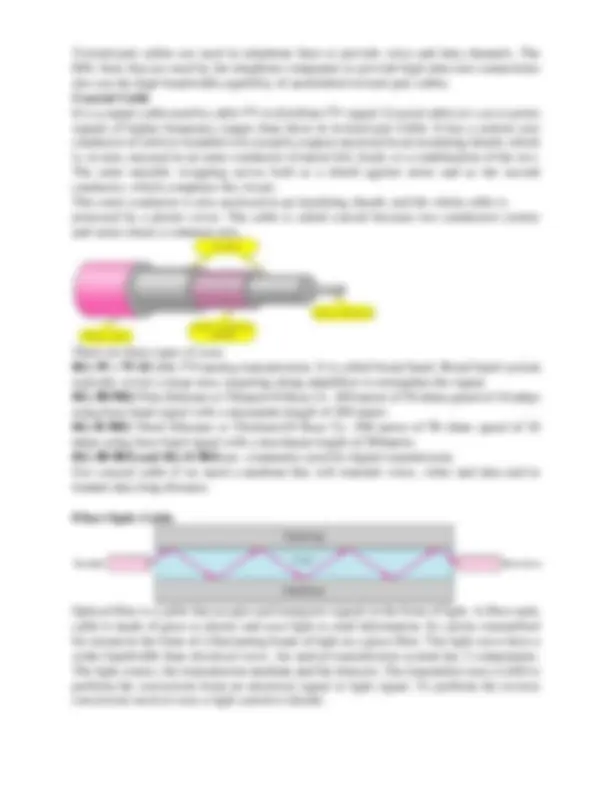
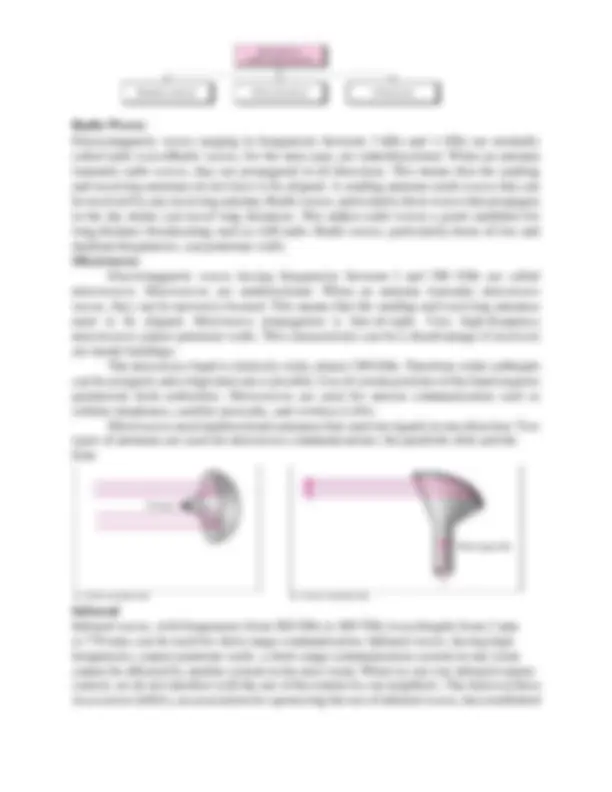

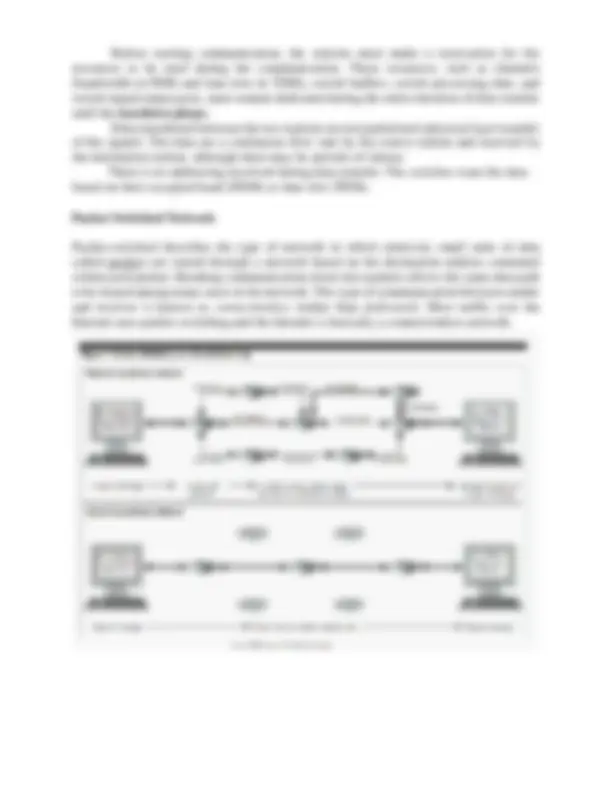


Study with the several resources on Docsity

Earn points by helping other students or get them with a premium plan


Prepare for your exams
Study with the several resources on Docsity

Earn points to download
Earn points by helping other students or get them with a premium plan
Community
Ask the community for help and clear up your study doubts
Discover the best universities in your country according to Docsity users
Free resources
Download our free guides on studying techniques, anxiety management strategies, and thesis advice from Docsity tutors
The concept of bandwidth utilization and multiplexing techniques. It explains the different types of multiplexing techniques such as FDM, TDM, and spread spectrum. It also covers transmission media, switching, and the use of guided and unguided media. a detailed explanation of frequency-division multiplexing (FDM) and spread spectrum techniques. It also discusses the use of twisted-pair cables and coaxial cables in telecommunications. useful for students studying computer networks and telecommunications.
Typology: Study notes
1 / 17

This page cannot be seen from the preview
Don't miss anything!










Bandwidth utilization:-Multiplexing: FDM, TDM, spread spectrum, Transmission
Media:- guided media and unguided media, Switching: message, Circuit and packet
switched networks, datagram networks, virtual-circuit networks.
Bandwidth Utilization: Multiplexing and Spreading Bandwidth utilization is the wise use
of
available bandwidth to achieve specific goals.Efficiency can be achieved by multiplexing;
i.e., sharing of the bandwidth between multiple users.
MULTIPLEXING Whenever the bandwidth of a medium linking two devices is greater
than the bandwidth needs of the devices, the link can be shared. Multiplexing is the set of
techniques that allows the (simultaneous) transmission of multiple signals across a single
data link. As data and telecommunications use increases, so does traffic.
Dividing a link into channels
In a multiplexed system, n lines shares the bandwidth of one link. The lines on the n input
lines on the left direct their transmission streams to a multiplexer which combines them
into a single stream(many to one). At the receiving end, that stream is fed in to
demultiplexer which separate a stream backs into its components transmission(one to
many). Here link is the physical path and channel refers to the portion of a link that carries
a transmission between a given pair of line.
There are 3 basic multiplexing techniques.
Categories of multiplexing
FDM is an analog technique that can be applied when the bandwidth of a link (in hertz) is greater than the combined bandwidths of the signals to be transmitted. In FDM, signals generated by each sending device modulate different carrier frequencies. These modulated signals are then combined into a single composite signal that can be transported by the link. Carrier frequencies are separated by sufficient bandwidth to accommodate the modulated signal. These bandwidth ranges are the channels through which the various signals travel. Channels can be separated by strips of unused bandwidth-guard bands-to prevent signals from overlapping. In addition, carrier frequencies must not interfere with the original data frequencies. Here In this illustration, the transmission path is divided into three parts, each representing a channel that carries one transmission
We consider FDM to be an analog multiplexing technique; however, this does not mean that FDM cannot be used to combine sources sending digital signals. A digital signal can be converted to an analog signal before FDM is used to multiplex them. Multiplexing Process
It is a conceptual illustration of the multiplexing process. Each source generates a signal of a similar frequency range. Inside the multiplexer, these similar signals modulates different carrier frequencies (/1,12, and h). The resulting modulated signals are then combined into
involve optical signals transmitted through fiber-optic channels. The idea is the same: We are combining different signals of different frequencies. The difference is that the frequencies are very high.
Although WDM technology is very complex, the basic idea is very simple. We want to combine multiple light sources into one single light at the multiplexer and do the reverse at the demultiplexer. The combining and splitting of light sources are easily handled by a prism. Recall from basic physics that a prism bends a beam of light based on the angle of incidence and the frequency. Using this technique, a multiplexer can be made to combine several input beams of light, each containing a narrow band of frequencies, into one output beam of a wider band of frequencies. A demultiplexer can also be made to reverse the process.
Time Division Multiplexing(TDM)
We can divide TDM into two different schemes: synchronous and statistical
Synchronous Time-Division Multiplexing Time-division multiplexing (TDM) is a digital process that allows several connections to share the high bandwidth of a linle Instead of sharing a portion of the bandwidth as in FDM, time is shared. Each connection occupies a portion of time in the link. In the figure, portions of signals 1,2,3, and 4 occupy the link sequentially.
TDM is a digital multiplexing technique. Digital data from different sources are combined into one timeshared link.
In synchronous TDM, the data flow of each input connection is divided into units, where each input occupies one input time slot. A unit can be 1 bit, one character, or one block of data. Each input unit becomes one output unit and occupies one output time slot. However, the duration of an output time slot is n times shorter than the duration of an input time slot. If an input time slot is T s, the output time slot is Tin s, where n is the number of connections. Figure shows an example of synchronous TDM where n is 3.
In synchronous TDM each input connection has an allotment in the output even if it is not
sending data, but this can be inefficient.
Statistical Time-Division Multiplexing An output slot in synchronous TDM is totally occupied by data; in statistical TDM, a slot needs to carry data as well as the address of the destination. In synchronous TDM, there is no need for addressing; synchronization and preassigned relationships between the inputs and outputs serve as an address. In statistical multiplexing, there is no fixed relationship between the inputs and outputs because there are no preassigned or reserved slots. In statistical TDM, slots are dynamically allotted to improve bandwidth efficiency. Only when an input line has a slot sufficient of data to send is it given a slot in the output frame. In this, the number of slots in each frame is less than the number of input lines. The multiplexer check each input line in Round robin fashion it allocates a slot for an input line if the line has data to send. Otherwise it is skip the line and check the next line. TDM slot comparison
used for this hopping period and passes it to the frequency synthesizer. The frequency
synthesizer creates a carrier signal of that frequency, and the source signal modulates the
carrier signal.
E.g:here M is 8 and k is 3. The pseudorandom code generator will create eight different 3-
bit patterns. These are mapped to eight different frequencies in the frequency table
At hopping period 1, the pattern is 101. The frequency selected is 700 kHz; the source
signal modulates this carrier frequency. The second k-bit pattern selected is 111, which
selects the 900-kHz carrier; the eighth pattern is 100, the frequency is 600 kHz. After eight
hoppings, the pattern repeats, starting from 101 again.
Direct Sequence Spread Spectrum (DSSS)
The DSSS technique also expands the bandwidth of the original signal, but the process is
different. In DSSS, we replace each data bit with 11 bits using a spreading code. In other
words, each bit is assigned a code of ’ n’ bits, called chips, where the chip rate is ‘n’
times that of the data bit.
In a wireless LAN, the famous Barker sequence where 11 is 11. The chips in the chip
generator use polar NRZ encoding. If the original signal rate is N, the rate of the spread
signal is lIN. This means that the required bandwidth for the spread signal is 11 times larger
than the bandwidth of the original signal. The spread signal can provide privacy if the
intruder does not know the code.
A transmission medium is anything that can carry information from a source to a
destination. The transmission of an electrical signal requires a transmission medium. The
transmission medium is the physical path between the transmitter and receiver.
Transmission media are actually located below the physical layer and are directly
controlled by the physical layer.
Depending upon bandwidth, delay, cost and easy of installation and maintain various
physical media can be used. It is mainly classified into two.,guided and unguided.
Guided Media Which may constraints and guide the communication signal. Eg:- metallic cable and optical fiber. The use of long-distance communication using electric signals started with the invention of the telegraph by Morse in the 19th century. Communication by telegraph was
Twisted-pair cables are used in telephone lines to provide voice and data channels. The DSL lines that are used by the telephone companies to provide high-data-rate connections also use the high-bandwidth capability of unshielded twisted-pair cables. Coaxial Cable It is a copper cable used by cable TV to distribute TV signal. Coaxial cable (or coax) carries signals of higher frequency ranges than those in twisted pair Cable. It has a central core conductor of solid or stranded wire (usually copper) enclosed in an insulating sheath, which is, in turn, encased in an outer conductor of metal foil, braid, or a combination of the two. The outer metallic wrapping serves both as a shield against noise and as the second conductor, which completes the circuit. This outer conductor is also enclosed in an insulating sheath, and the whole cable is protected by a plastic cover. The cable is called coaxial because two conductors (centre and outer) share a common axis..
There are three types of coax RG-59 :-75 Ω Cable TV(analog transmission). It is called broad band. Broad band system typically covers a large area, requiring along amplifiers to strengthen the signal. RG-58 50Ω Thin Ethernet or Thinnet(10 Base 2):- 200 meter of 50 ohms,speed of 10 mbps using base band signal with a maximum length of 200 meter. RG-ll 50Ω Thick Ethernet or Thicknet(10 Base 5):- 500 meter of 50 ohms speed of 10 mbps using base band signal with a maximum length of 500metre. RG-58 50Ω and RG-ll 50Ω are commonly used for digital transmission. Use coaxial cable if we need a medium that will transmit voice, video and data and to tranmit data long distance.
Fiber-Optic Cable
Optical fiber is a cable that accepts and transports signals in the form of light. A fiber-optic cable is made of glass or plastic and uses light to send information. Its carries transmitted bit stream in the form of a fluctuating beam of light in a glass fiber. The light wave have a wider bandwidth than electrical wave. An optical transmission system has 3 components. The light source, the transmission medium and the detector. The transmitter uses a LED to perform the conversion from an electrical signal to light signal. To perform the reverse conversion receiver uses a light sensitive diaode.
Light propagate along the optical fiber for in one of the 3 ways depending on the type and width of core material used.
Multimode is so named because multiple beams from a light source move through the core in different paths. mutlimode fiber contains a core with a larger diameter that a single mode fiber. Due to the larger diameter many pulses of light which is generated by laser can travel at different angles. Advantages Very high bandwidth Less signal attenuation Immunity to electro magnetic interference Small size and light Safety and electrical insulation Security Analog and digital transmission. Disadvantages
Installation and maintenance. Fiber-optic cable is a relatively new technology. Its installation and maintenance require expertise that is not yet available everywhere. Unidirectional light propagation. Propagation of light is unidirectional. If we
Radio Waves Electromagnetic waves ranging in frequencies between 3 kHz and 1 GHz are normally called radio wavesRadio waves, for the most part, are omnidirectional. When an antenna transmits radio waves, they are propagated in all directions. This means that the sending and receiving antennas do not have to be aligned. A sending antenna sends waves that can be received by any receiving antenna. Radio waves, particularly those waves that propagate in the sky mode, can travel long distances. This makes radio waves a good candidate for long-distance broadcasting such as AM radio. Radio waves, particularly those of low and medium frequencies, can penetrate walls. Microwaves Electromagnetic waves having frequencies between I and 300 GHz are called microwaves. Microwaves are unidirectional. When an antenna transmits microwave waves, they can be narrowly focused. This means that the sending and receiving antennas need to be aligned. Microwave propagation is line-of-sight. Very high-frequency microwaves cannot penetrate walls. This characteristic can be a disadvantage if receivers are inside buildings. The microwave band is relatively wide, almost 299 GHz. Therefore wider subbands can be assigned, and a high data rate is possible. Use of certain portions of the band requires permission from authorities. Microwaves are used for unicast communication such as cellular telephones, satellite networks, and wireless LANs. Microwaves need unidirectional antennas that send out signals in one direction. Two types of antennas are used for microwave communications: the parabolic dish and the horn
Infrared Infrared waves, with frequencies from 300 GHz to 400 THz (wavelengths from 1 mm to 770 nm), can be used for short-range communication. Infrared waves, having high frequencies, cannot penetrate walls. a short-range communication system in one room cannot be affected by another system in the next room. When we use our infrared remote control, we do not interfere with the use of the remote by our neighbors. The Infrared Data Association (IrDA), an association for sponsoring the use of infrared waves, has established
standards for using these signals for communication between devices such as keyboards, mice, PCs, and printers. Infrared signals can be used for short-range communication in a closed area using line-of-sight propagation.
A network is a set of connected devices. Whenever we have multiple devices, we have the problem of how to connect them to make one-to-one communication possible. One solution is to make a point-to-point connection between each pair of devices (a mesh topology) or between a central device and every other device (a star topology). These methods are impractical and wasteful when applied to very large networks. A better solution is switching. A switched network consists of a series of interlinked nodes, called switches. Switches are devices capable of creating temporary connections between two or more devices linked to the switch. In a switched network, some of these nodes are connected to the end systems (computers or telephones, for example). Others are used only for routing.
The end systems (communicating devices) are labeled A, B, C, D, and so on, and the switches are labeled I, II, III, IV, and V. Each switch is connected to multiple links. Three methods of switching have been important: circuit switching, packet switching, and message switching. The first two are commonly used today. The third has been phased out in general communications but still has networking applications.
Circuit switched networks A circuit-switched network consists of a set of switches connected by physical links. A connection between two stations is a dedicated path made of one or more links.In circuit switching, the resources need to be reserved during the setup phase; the resources remain dedicated for the entire duration of data transfer until the teardown phase. The end systems, such as computers or telephones, are directly connected to a switch. When end system A needs to communicate with end system M, system A needs to request a connection to M that must be accepted by all switches as well as by M itself. This is called the setup phase ; a circuit (channel) is reserved on each link, and the combination of circuits or channels defines the dedicated path. After the dedicated path made of connected circuits (channels) is established, data transfer can take place. After all data have been transferred, the circuits are tear down. Circuit switching takes place at the physical layer.
In data communications, we need to send messages from one end system to another. If the message is going to pass through a packet-switched network, it needs to be divided into packets of fixed or variable size. In packet switching, there is no resource allocation for a packet. Resources are allocated on demand. The allocation is done on a firstcome, first-served basis. In a datagram network, each packet is treated independently of all others. Even if a packet is part of a multipacket transmission, the network treats it as though it existed alone. Packets in this approach are referred to as datagrams.
Datagram switching is normally done at the network layer.The switches in a datagram network are traditionally referred to as routers.
The datagram networks are sometimes referred to as connectionless networks. The term connectionless here means that the switch (packet switch) does not keep information about the connection state. There are no setup or teardown phases. Each packet is treated the same by a switch regardless of its source or destination. A switch in a datagram network uses a routing table that is based on the destination address. The destination address in the header of a packet in a datagram network remains the same during the entire journey of the packet. Switching in the Internet is done by using the datagram approach to packet switching at the network layer. VIRTUAL-CIRCUIT NETWORKS A virtual-circuit network is a cross between a circuit-switched network and a datagram network. It has some characteristics of both.
to the data transfer phase 2.Resources can be allocated during the setup phase, as in a circuit-switched network, or on demand, as in a datagram network.
The network has switches that allow traffic from sources to destinations. A source or destination can be a computer, packet switch, bridge, or any other device that connects other networks. Switching at the data link layer in a switched WAN is normally implemented by using virtual-circuit techniques.